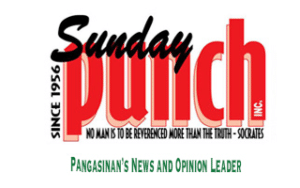Punchline
The illegal fish pens are back

By Ermin Garcia Jr.
EARLY this year, Dagupan City Administrator Alvin Fernandez announced that the city will finally rid the city’s rivers of illegal fish pens to help improve the rivers’ sustainability and protect the investments of legitimate fish farmers. The PUNCH even published a photo showing him leading the demolition of the illegal fish pens.
But either our eyes are lying to us or he has since been afflicted with sore eyes that he can’t seem to see that more fish pens have mushroomed in the city’s tributaries since. Whether these are illegal or not, is for him to point out but the issue I raise is the worsening situation that’s waiting for another fish kill to occur. Also, what I do know is that more fish pens mean more chemical feeds to dump at the bottom of the city’s rivers.
What we are seeing today is again the picture of greed, of unscrupulous businessmen with some corrupt city officials in their pockets exploiting the city’s natural resources. The dumping of feeds is just as destructive as the cutting of trees in the mountains. One fish kill translates to millions lost in investments and higher prices of fish for the medium term, beyond the reach of those who have less in life and live by a lowly fish diet.
If posting a picture of the city administrator weekly showing him demolishing 50 pens each time will do the trick, hey, the PUNCH will just be too happy to do this.
* * * * *
ROAD MENACES BY NIGHT. Here’s a long-overdue life-saving task for cops, POSO details and barangay tanods of the cities that are on duty at night.
There are hundreds of road menaces plying city streets in the province at night. I refer to the PUJs and PUBs that roam the city streets with just their front park lights on, their headlights off and God knows if their rear lights are functioning.
If I follow the drivers’ idiotic logic, it goes this way – there are enough streetlights that enable them to see what’s ahead of them, hence, they could save on the life of their batteries by turning their headlights off! And if they could see, so too could others, meaning they can be seen by other motorists as well! So, why turn on your headlights? (Note: I’ve heard jeepney drivers who argued that the vehicles that hit them head-on should have seen them since they (the latter) had their park lights on! Kasalanan pa ng may headlight!).
This practice has been going on since the calesas’s glory days, plying city streets without headlights and relied simply on the horses’ limited eyesight!
The situation makes me wonder if our cops are even aware that motorists who don’t turn on their headlights when driving at night are violating basic traffic rules! As I’m certain many of our cops and LTO enforcers (on and off-duty) have seen this flagrant violation by jeepney and bus drivers, I cannot but wonder why the “no-lights” habit continues to be tolerated at the risk of pedestrians and commuters’ lives. Is it possible that our city cops and LTO enforcers never studied and took the written exams for a driver’s license themselves like most of the erring jeepney and bus drivers not to know this?
If the city cops would rather sleep at night, perhaps the more diligent barangay tanods can do a better job at securing their neighbors’ welfare by requiring all vehicles that pass through their area to turn on their headlights.
* * * * *
FAIRNESS IN MEDIA. My esteemed colleagues in Pangasinan need not fear the future with a ‘right of reply’ law in place. It’s not going to happen. The Supreme Court will not allow it to breath one day in our constitutionally protected democratic space. Even under the dictatorship regime (1972-1986), to see a pliant media that far was only good for wishful thinking.
In hindsight, I am happy that efforts to pass the bill were revived last year. Not that I favor its passage but the brouhaha has brought the issue of fairness and corruption in media in sharper focus. It has served as a friendly reminder to us in media about the need to be fair and to be zealous about our respective integrity as media practitioners at all times. To be critical is inherent in being a watchdog of government but to be fair and be sensitive about our individual and collective integrity are added values to gain respect and credibility.
Looking beyond the manifested objectives of the bill’s authors in both chambers of congress, the renewed call for a law on right of reply is actually a protest call against the unabated corruption and unprofessional practices in the media circle. Simply put, politicians (both honest and corrupt) and businessmen continue to accuse many members of media for being active adherents to A.C.-D.C. brand of journalism: To attack and collect; to defend and collect! Still other practitioners have become even more enterprising by adding S.C. – Be silent and collect! This is on top of the “envelope-mental journalism” and most recently, “ATM journalism”!
Yes, the bottom-line issue of the bill is unabated corruption made possible by unethical and unfair practices by media practitioners.
The protest rally staged by the 3 major media groups in the province last week was a timely exercise. But am afraid, standing up like they did simply without responding concretely to the issue on the need for fairness and to check corruption in their ranks, only serves to worsen the situation. That would be like sweeping the dirt under the rug for the nth time!
If the PPRC, PATRIMA, KBP seriously want to impress upon our lawmakers and communities that, indeed, a law on right of reply is not needed, they should seriously consider organizing a Media Practice Council that they will support. Such a council should be mandated to address complaints on unethical practices, failure of media establishments to provide news subjects who feel aggrieved, the space and airtime for their reactions. Both the Metro Manila and Metro Cebu media have a similar one in place.
So, guys and gals ’tis time to be true. (Translation: Magpakatotoo na tayo!)






